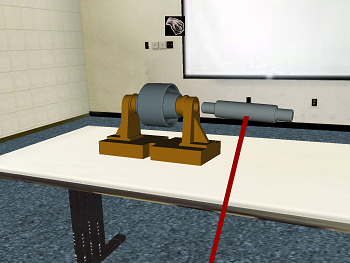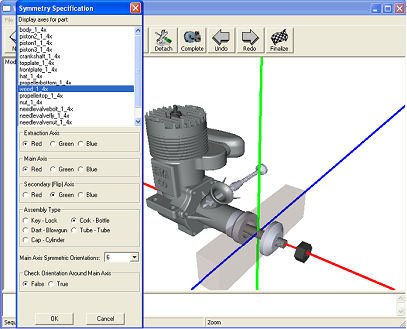![]() Virtual Training Studio
Virtual Training Studio
PI: Prof. S.K. Gupta
We have developed a personal virtual environment (PVE)-based virtual assembly system called Virtual Training Studio (VTS). The current system focuses mainly on the cognitive aspects (e.g., ability to recognize the correct part, to correctly orient the part in space, remembering the right assembly sequence). The PVE consists of a head mounted stereo display with head tracking and a wand for user interaction. This PVE gives the user a complete 3D immersive experience during virtual assembly. The VTS aims to improve existing training methods through the use of a virtual environment-based multi-media training infrastruc¬ture that allows users to learn using different modes of instruction presentation while focusing mainly on cognitive aspects of training.
The Virtual Training Studio is a suite of tools, which currently consists of the Virtual Author, Virtual Workspace, and Virtual Mentor. With Virtual Training Studio, training instructors have the option of employing multi-media options such as 3D animations, videos, text, audio, and interactive simulations to create multi-media training instructions. The virtual environment enables trainees to practice training instructions, using interactive simulation and hence reduces the need for practicing with physical components.
Training
Trainers and trainees interact with the system, using a Head-Mounted Display (HMD) and a wireless wand. Four optical trackers (infrared cameras) and two gyroscopes are used to track the position and orientation of the user’s head and the wand. The wand consists of an off-the-shelf wireless presenter, an infrared LED, and a wireless gyroscope. Inside the virtual reality environment, the user can manipulate the CAD models and the buttons using a virtual laser pointer, which is controlled by the wireless wand. A wireless gyroscope and another infrared LED are mounted on the HMD. The cameras track the two LEDs to determine position. Trainees interact with a component of the VTS called Virtual Workspace. The goal of this component of the VTS is to provide the basic infrastructure for multimodal training. Virtual Workspace offers three primary modes of training: (1) 3D Animation Mode which allows users to view the entire assembly via animations, (2) Interactive Simulation Mode, which is a fully user driven mode that allows users to manually perform the assembly tasks, and (3) Video Mode, which allows users to view the entire assembly via video clips.
The Virtual Mentor module simulates the classical master-apprentice training model by monitoring the actions of the user in the Virtual Workspace and assisting the user at appropriate times to enhance the trainee’s understanding of the assembly/disassembly process. The Virtual Author enables the instructor to quickly create multi-media training instructions for use in the Virtual Workspace without writing any code.
Performance
System performance was assessed using thirty subjects and two tutorials. The first study involved a rocket motor and 94 percent steps were performed correctly by the users during the physical demonstration after completing the training. In the second study, using a model airplane engine, 97 percent steps were performed correctly.



